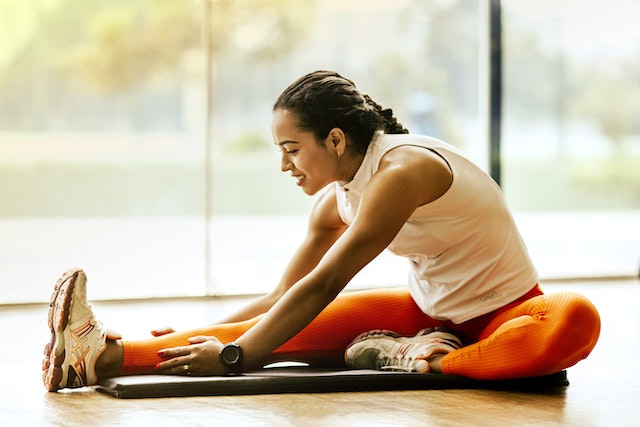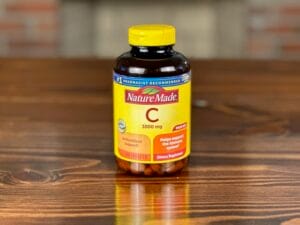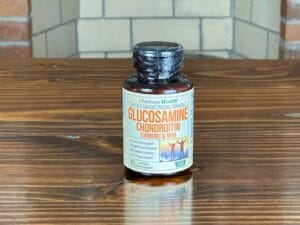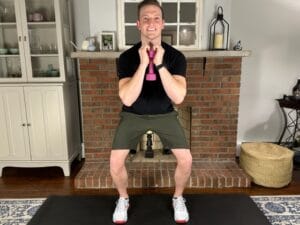Looking for the best treatments and exercises to treat your torn meniscus from home?
If you’re looking for the most current and evidence-based treatments to heal your torn meniscus, then you’re in the right place! A torn meniscus is one of the most common disorders of the knee that we treat in the clinic. Because of this, we have developed a very simple but very effective treatment program, that we teach our patients, in order to alleviate their knee pain.
This article will cover all of the treatments, exercises, and equipment we use for our patients in the clinic. We will go over the ins and outs of what the meniscus is and how it can be injured. Then we’ll dive in deep to all the treatments that we use to rehabilitate hundreds of patients. These have all been tested many times over and are by far the best at home exercises for a torn meniscus that you can be doing.
And then don’t forget to stick around at the end of the article for our most frequently asked questions. If you’re looking to get started right away, then check out our Quick Guide to treating a torn meniscus directly below.
Disclaimers and Disclosures: All information in this article is for informational and educational purposes only and should not be taken as individual medical advice. Additionally, this article contains affiliate links, meaning when you make a purchase, we make a small commission at no additional cost to you. For more information, see our full Disclaimers and Disclosures.
Quick Guide Phase 1: Best Physical Therapy Exercises to Treat a Torn Meniscus from Home in Weeks 0-2
1. Hamstring stretch with a strap, lying on your back

- Stretches the hamstring muscle on the back of your thigh
- Hold this stretch for 20 seconds and repeat 5 times
- Perform this stretch 2 times per day
- Best Stretching Strap in the link below
2. Calf stretch with a strap, lying on your back
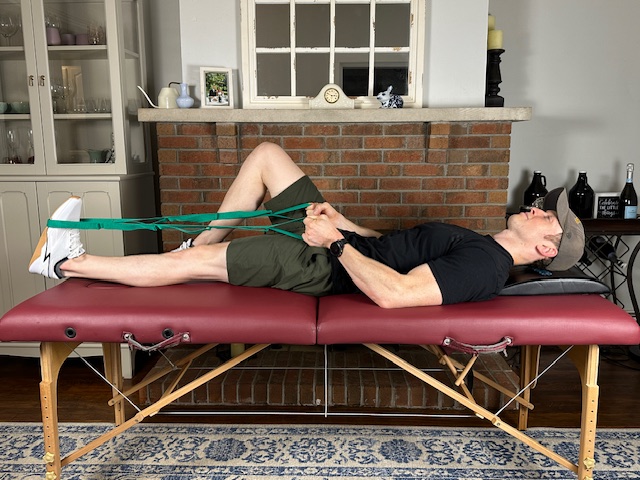
- Stretches the calf muscle on the back of the lower leg
- Hold this stretch for 20 seconds and repeat 5 times
- Perform this stretch 2 times per day
- Best Stretching Strap in the link below
3. Quad set with towel roll
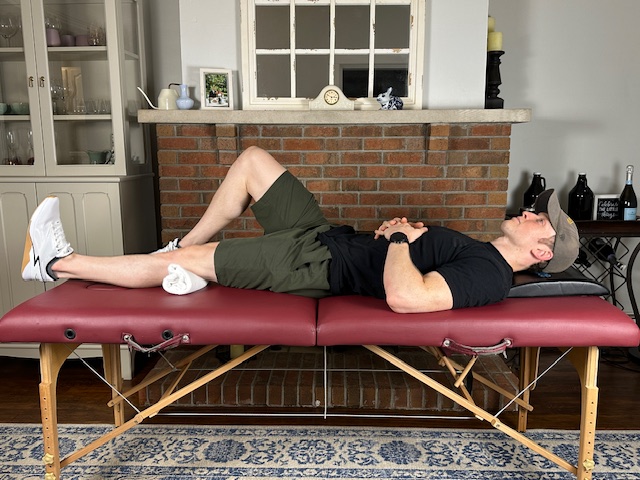
- Activates the quad muscle on the front of your thigh
- Tighten you thigh for 3 seconds and repeat 20 times
- Perform this exercise 2 times per day
- Best Thick Yoga Mat in the link below
4. Straight Leg Raise
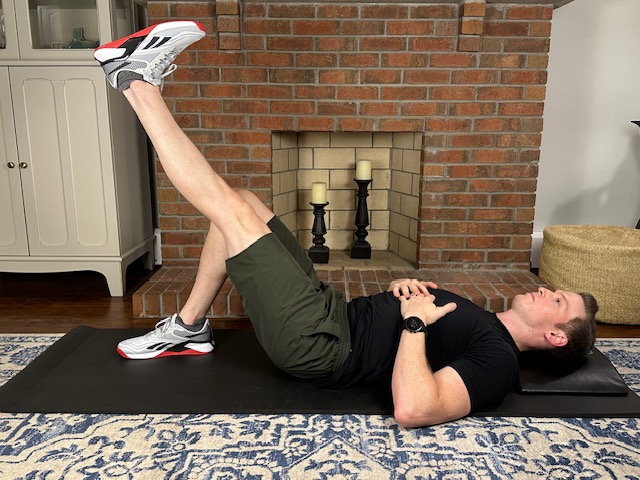
- Strengthens the quad muscle on the front of your thigh
- Raise your leg straight off the table and back down, repeat 10 times
- Complete 2 sets and perform this exercise 2 times per day
- Best Thick Yoga Mat in the link below
5. Short Arc Quad
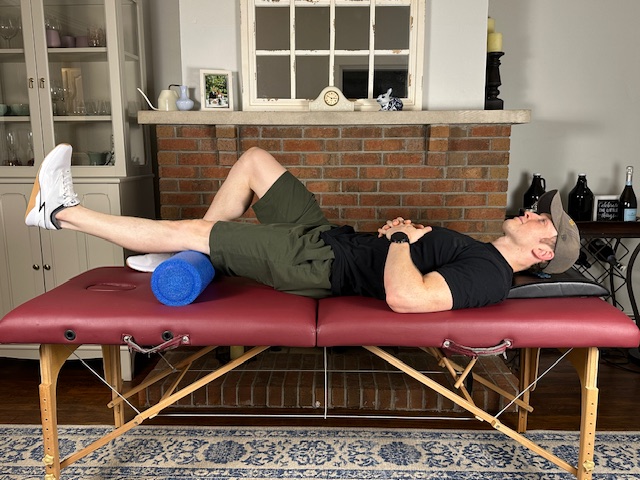
- Strengthens the quad muscle on the front of your thigh
- Kick your heel off the table to straighten your knee, repeat 15 times
- Complete 2 sets and perform this exercise 2 times per day
- Best Ankle Weights in the link below
6. Leg extension with an ankle weight
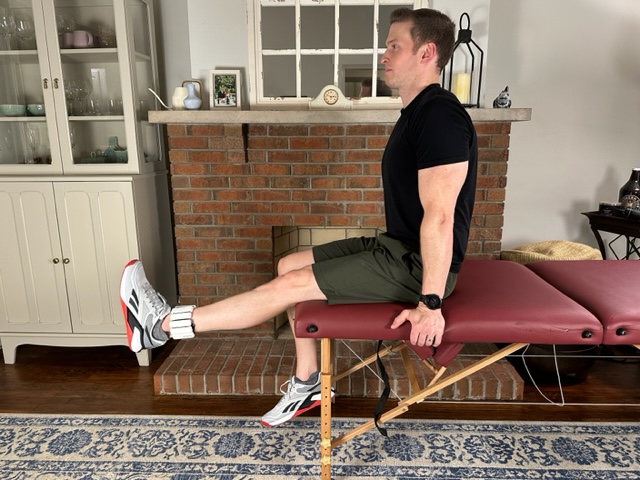
- Strengthens the quad muscle on the front of the thigh
- Kick your leg straight out 15 times and repeat for 2 sets
- Perform this exercise 2 times per day
- Best Ankle Weights for this exercise in the link below
7. Heel slides with a strap, lying on your back

- Improves range of motion in the knee joint
- Hold this stretch for 10 seconds and repeat 10 times
- Perform this exercise 2 times per day
- Best Stretching Strap in the link below
Bonus: Helpful equipment for treating a torn meniscus: Ice and TENS for inflammation and pain
Quick Guide Phase 2: Best Physical Therapy Exercises to Treat a Torn Meniscus from Home in Weeks 2-6
1. Calf stretch on a slant board

- Improves calf flexibility and knee extension range of motion
- Hold this stretch for 20 seconds and repeat 5 times
- Perform this exercise 2 times per day
- Best Slant Board in the link below
2. Heel raises and toe raises
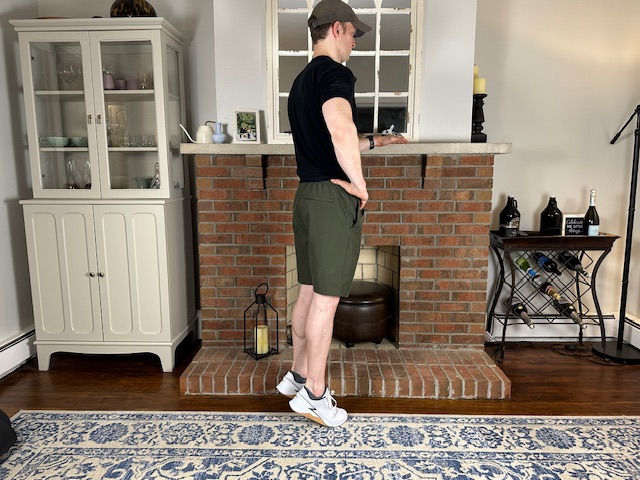
- Improves strength in the calf and shin muscles below your knee
- Raise forward on your toes and back on your heels 20 times
- Perform this exercise 2 times per day
- Hold on to counter or other sturdy object for balance
3. Cone step over
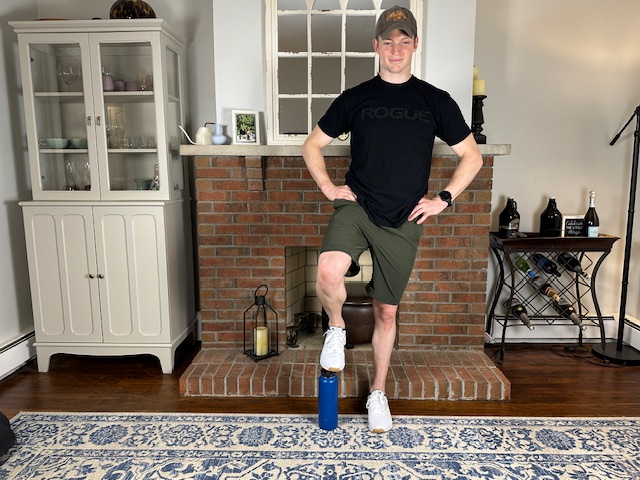
- Encourages active knee flexion and initiation of lateral movement
- Step over a cone target and back to the start 20 times
- Perform this exercise 2 times per day
- Best Stackable Cones in the link below
4. Step ups
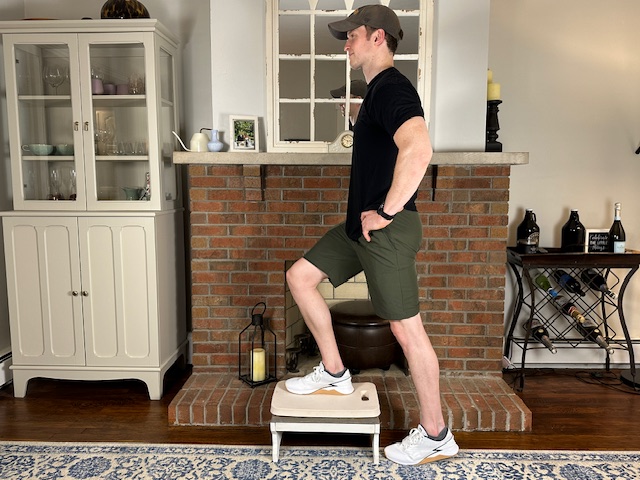
- Strengthens the quads, glutes, and hamstrings in a weight-bearing position
- Step up onto a stepper and return to the start position 10 times
- Complete 2 sets and perform this exercise 2 times per day
- Best Mini Stepper in the link below
5. Lateral step overs
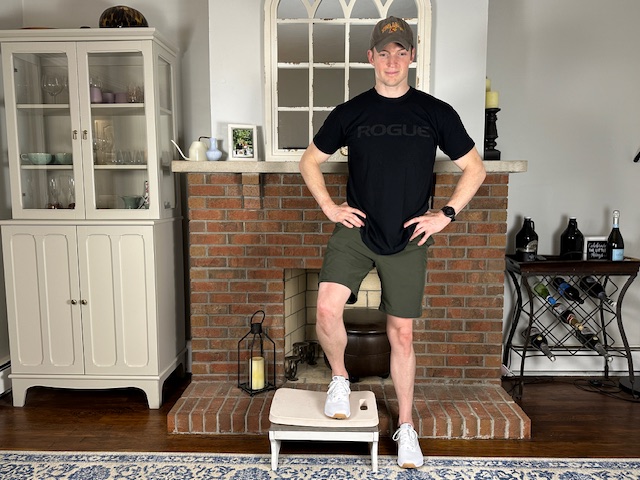
- Strengthens the quads, glutes, and hamstrings in a weight-bearing position
- Step up sideways onto a stepper, then to the other side, and return to the start position 10 times
- Complete 2 sets and perform this exercise 2 times per day
- Best Mini Stepper in the link below
6. Bridge with resistance band
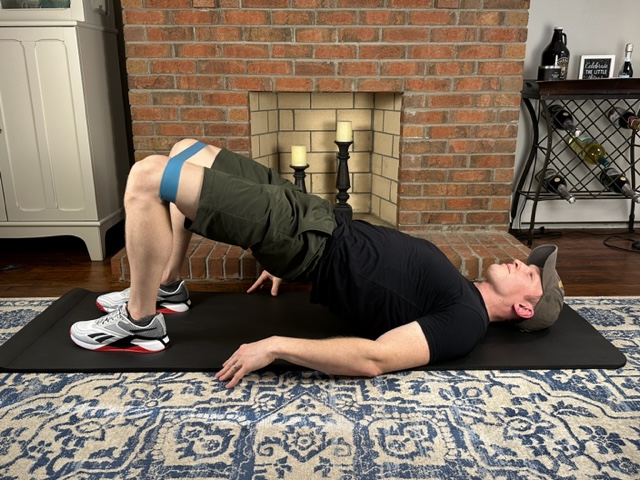
- Strengthens the quads, glutes, and hamstrings in a partial weight-bearing position
- Lift your hips and push your knees apart for a 3 second hold, repeat 10 times
- Complete 2 sets and perform this exercise 2 times per day
- Best Resistance Bands in the link below
What is a knee meniscus and what’s its purpose?
The knee meniscus is a C-shaped piece of cartilage that sits between the thigh bone (femur) and the shin bone (tibia). There are actually two menisci in each knee—a medial and a lateral—that sit right next to each other. It is this distinctive shape that dictates the meniscus’s function within the knee joint.
The meniscus is designed to increase stability as well as cushioning within the knee. The C-shape of the meniscus “cups” the end of the femur bone which prevents excess movement and provides more stability. On the other hand, the fibrocartilage that makes up the meniscus provides cushioning and shock absorption during activities such as walking and running.
What causes a meniscus tear?
The most common cause of a meniscus tear is forceful twisting or pivoting on a bent knee. When you are standing on a bent knee, the meniscus is performing its normal function of stabilizing and cushioning the knee. However, when you are in this position and then twist or pivot, this causes your femur to shear across the meniscus which can then cause a tear.
If you are on the younger side, then the most common cause of a meniscus tear is cutting or pivoting during a sporting event. This is because the meniscus is healthy and more pliable, so it takes a lot of force to cause a tear. However, if you are on the older side or have a meniscus that is less supple, then you can tear your meniscus simply by going down the stairs and tweaking your knee.
This second scenario is called a degenerative meniscus tear. As we age, we start to develop a little arthritis and some microtrauma to the cartilage that accumulates over the years. I tell my patients to think of it like “the straw that broke the camel’s back”. You didn’t do anything wrong; it was just the cumulative effect over time and it happened to be too much at that moment.
How do I know I have a meniscus tear?
The gold standard for diagnosing a meniscus tear is having an MRI reviewed by your doctor. However, there are a number of signs and symptoms we can evaluate that provide a good indication if your knee pain is stemming from a meniscus tear.
The 5 indications of a torn meniscus:
-Pain or tenderness around the knee joint
-Catching or locking sensation in the knee
-Pain with hyperextension (forced straightening of the leg)
-Pain with maximum flexion (forced bending of the knee)
-Swelling in or around the knee after the initial injury
These are the tests that I perform on my patients in the clinic. If you have 3 or more of these symptoms, there is a 90% chance you have a torn meniscus. The most important symptoms I focus on in the clinic are: if you have a sudden onset of knee pain, with a little bit of swelling, and it hurts to straighten as well as bend your knee all the way.
How do I treat a torn meniscus from home?
The best way to treat a torn meniscus is to reduce the swelling and inflammation, restore range of motion and flexibility, and strengthen the muscles surrounding the knee. All of these goals can be accomplished with a graded exercise program. Initially, these exercises should be performed in a non-weightbearing position in order to take stress off the meniscus.
As range of motion and strength are restored though, we want to transition to weightbearing exercises. This will help to further strengthen the supporting muscles surrounding the knee. All of these exercises will work to reduce your knee pain and help you return to the activities you love to do.
Over years of practice, we have created a comprehensive program of exercises and treatments that we use for our patients in the clinic. This program is covered in detail below. We have included pictures as well as descriptions of how to perform the exercises, how often you should do them, and professional tips that we give our patients.
On a final note, we often get questions as to what the best equipment is to treat a torn meniscus. For convenience, we have included links to the equipment we use with our patients or recommend will help to alleviate your symptoms. We hope you have as much success with them as our patients do!
The best at home physical therapy treatments and most important equipment for a torn meniscus; In-depth descriptions
Beginning exercises and treatments for a meniscus tear.
If someone came to the clinic and wanted a program for a meniscus tear, then I would tell them these are the best at home physical therapy exercises for a torn meniscus that they can be doing. For the best results, the following exercises should be performed 2 times per day, every day of the week. The beginning level treatments should last 1-3 weeks before progressing to the intermediate level treatments that follow.
1. Hamstring stretch with a strap, lying on your back

Why stretching the hamstring muscle is important for a torn meniscus.
The hamstring is the big muscle on the back of your thigh and it crosses behind the knee joint. When you tear your meniscus, the hamstring tightens up and restricts your mobility. By stretching out your hamstring, you will begin to restore normal mobility to your knee.
How to perform the hamstring stretch with a strap exercise for a meniscus tear.
Start by lying on your back with both legs straight and the strap around the middle of your foot. Keep your knee straight and use the strap to pull your leg straight up until you feel a stretch in the back of your leg. Once you feel the stretch, hold it for 20 seconds and then lower back down to the start position. Rest for a second or two and repeat this 5 times.
Professional tips: Having a slight bend in your knee is ok to start out. But as your body gets used to this stretch, you should work to keep your knee as straight as possible.
What is the best equipment for performing the hamstring stretch?
The Stretch Out Strap is the best option for several reasons. It is 6 feet long and has multiple loops and handles all along its length. This makes it good for people of different sizes and allows you to get the most comfortable grip. It is also very durable and we have had thousands of patients use it in our clinic and most of them end up buying one for their own use at home.
It’s also nice to have a firm but soft surface to perform this stretch on. A thick yoga mat is an easy solution to this problem and I use one for my stretches at home. You can also use a massage table, which is nice if you struggle to get up and down from the floor. This massage table is collapsible and portable and allows you to perform your physical therapy routines at home like our patients do in the clinic.
2. Calf stretch with a strap, lying on your back

Why the calf stretch is important for treating a torn meniscus.
The calf is the big muscle on the back of your lower leg and like the hamstring muscle, it crosses behind the knee joint. When you tear your meniscus the calf muscle becomes tight. Not only does this restrict your knee mobility, but it also can cause a limp. Stretching out the calf will increase your knee mobility and help to get rid of any limp.
How to perform the calf stretch with a strap exercise for a torn meniscus.
Start by lying on your back with your leg straight and the strap around the ball of your foot. Keep your knee straight and pull your foot and toes back toward you by pulling on the strap. Once you feel the stretch in the back of your leg, hold it for 20 seconds and repeat 5 times.
Professional tip: If you can’t feel the stretch at first, actively pull your toes toward your nose first, and then give extra pressure by pulling on the strap.
What is the best equipment for performing the calf stretch with a strap?
This is probably the best news of the day, because you can use the exact same equipment that you used for the hamstring stretch above. The Stretch Out Strap has a lot of utility and we have our patients use it for over 20 different stretches. The Yoga Mat and Massage Table are also perfect for a variety of stretches and both can be folded up and stored away when not in use.
3. Quad sets lying on your back, with a towel roll

Why the quad set exercise is important for treating a torn meniscus.
The quadricep is the big muscle on the front of your thigh. When you have pain or swelling in your knee joint, it essentially shuts your quadricep off. Think of it like a neurologic reflex loop, where the pain in your knee tells your quad muscle to stop working.
It then takes repeated activation of this muscle in order to get it to fully turn back on again. This is the first step in regaining strength in the quadricep and restoring normal function to your knee.
How to perform the quad set exercise with a towel roll for a torn meniscus.
Start by lying on your back with your knee straight and a small rolled up towel behind your knee. Tighten your thigh muscle and push the back of your knee into the towel roll. Focus on feeling a squeeze in the muscle on the front of your thigh and hold it for 2-3 seconds. Then relax and repeat this 20 times.
Professional tips: This exercise is also designed to help you regain full extension range of motion. Because of this, it can be a little uncomfortable when you first start. This is normal as long as the discomfort is tolerable and not getting worse.
What is the best equipment for performing the quad set exercise?
A rolled-up hand towel that is a couple inches in diameter will work just fine. The purpose of the towel is to provide a little cushioning behind the knee and, more importantly, give you some feedback that you’re pressing your knee straight.
4. Straight leg raise, lying on your back

Why the straight leg raise is important for treating a torn meniscus.
The purpose of the straight leg raise is to strengthen the quadricep muscle. The quad works as a shock absorber to dissipate forces on the knee. This is a similar function to the meniscus, which acts as a cushion between the thigh bone and shin bone. The stronger we can make the quad muscle, the more force this will help to take off the meniscus.
How to perform the straight leg raise exercise for a torn meniscus.
Start lying on your back with your involved leg straight and your uninvolved leg bent to a 90 degree ankle. Tighten the muscle on the front of your thigh, keep your leg straight, and lift it off the table until it is parallel to your other thigh. Pause for a second and then return to the starting position. Repeat this 10 times, take a 30 second break, and perform 2 sets.
Professional tips: Most of my patients will lift their leg a little too high to start. If you go too far though, you will actually lose tension in the muscle and it makes the exercise less effective. Lift your leg just until your knees are the same height and that will do the trick.
5. Short arc quad, with an ankle weight

Why the short arc quad exercise is important for treating a meniscus tear.
The quad becomes weakest at the end range of extension after a meniscal injury. It is important to be strong in this range of motion for activities such as standing, walking, and going up and down stairs. This exercise specifically works to strengthen your quad at the end range of extension, which will eventually allow you to get back to these activities.
How to perform the short arc quad exercise for a torn meniscus.
Start lying on your back with a bolster under your knee. Slowly, kick your heel off the table until your leg is straight but make sure the back of your knee stays in contact with the bolster. Try to tighten your quad muscle at the top position and then return to the start. Repeat this 15 times, take a 30 second break, and perform 2 sets.
Professional tips: The first time you do this exercise try it without any weight. If it is easy and relatively pain-free then you can try adding a pound to the ankle weight. Slowly keep adding weight over the days and weeks, but it’s better to go a little slower rather than overdoing it.
What is the best equipment for performing the short arc quad exercise?
It is important for the ankle weights to fit comfortably and securely around your ankle. Another really nice feature is the ability to adjust the amount of weight that it holds. These ankle weights meet all of these criteria, are highly rated, and are sold in pairs which can give you even more weight to use if you’re feeling extra strong!
The bolster that your knee is supported on should be firm but comfortable. A diameter of about 6 inches works best, so a foam roller is my favorite piece of equipment for this exercise. It’s also really nice because you can use it for other mobility work you may do such as rolling out your quads, IT band, and hamstrings. I love getting pieces of equipment that can serve a bunch of different purposes and be used over and over again.
6. Leg extension with an ankle weight.

Why the leg extension exercise is important for treating a torn meniscus.
The leg extension exercise is similar to the short arc quad, except you’re moving your knee through a full range of motion. So similarly, you are strengthening your quad muscle through that full range of motion as well. This will help for activities that require larger ranges of motion, such as standing up from a chair, getting up from the floor, and pretty much every sport activity out there.
How to perform the leg extension exercise for a meniscus tear.
Start sitting in a chair or on the side of your bed with your knees bent. Slowly kick your foot all the way out until your leg is straight and the back of your thigh is still on the surface. Try to tighten your quad at the top position for a second and then return to the start position. Repeat this 15 times, take a 30 second break, and perform 2 sets.
Professional tips: Just like the short arc quad exercise, the first time should be performed without any weight. If the exercise is easy and relatively pain-free then you can add a pound to the ankle weight and slowly keep progressing to build back the strength in your quadriceps.
What is the best equipment for the leg extension exercise?
It is important for the ankle weights to fit comfortably and securely around your ankle. Another really nice feature is the ability to adjust the amount of weight that it holds. These ankle weights meet all of these criteria, are highly rated, and are sold in pairs which can give you even more weight to use if you’re feeling extra strong!
7. Heel slides with a strap, lying on your back.

Why the heel slides exercise is important for treating a torn meniscus.
The ability to bend your knee all the way is limited after tearing your meniscus. In the short term, this loss of motion is due to swelling and pain within the knee joint. But if this limited motion is allowed to persist, it will cause tightness in the capsule that surrounds your knee, which can then lead to permanent loss of motion. The heel slide exercise will work to restore full flexion range of motion to your knee.
How to perform the heel slides exercise for a torn meniscus.
Start lying on your back with the strap around the middle of your foot. Try to relax your leg and slowly pull on the handles of the strap so your knee bends and your heel slides up toward your butt. Keep pulling until you feel just a gentle stretch across your knee. Once you feel the stretch, hold it there for 10 seconds then return to the start position and repeat 10 times.
Professional tips: I usually tell people this exercise is most people’s least favorite for the first couple of weeks due to the discomfort associated with it. So if you’re feeling this discomfort then you’re in good company. This is normal, but we want it to be very tolerable and the pain should go away very quickly when you’re done with the exercise, if not then be gentler.
What is the best equipment for the heel slides exercise?
The stretch out strap is the best alternative for several reasons. It is 6 feet long and has multiple loops and handles all along its length, so it is good for people of different sizes and allows you to get the most comfortable grip. It is also very durable and we have had thousands of patients use it in our clinic and most of them end up buying one for their own use at home.
We want your heel to slide with as little friction as possible. If you’re doing this exercise on your hardwood floors with socks on, then consider this pretty frictionless. However, if you’re exercising on a yoga mat, on a couch, or in your bed then using a slide board can be helpful to make this exercise nice and smooth. We use the slide board for our patients in the clinic when they’re on the mat tables and need a smooth surface.
8. Ice and TENS for inflammation and pain.
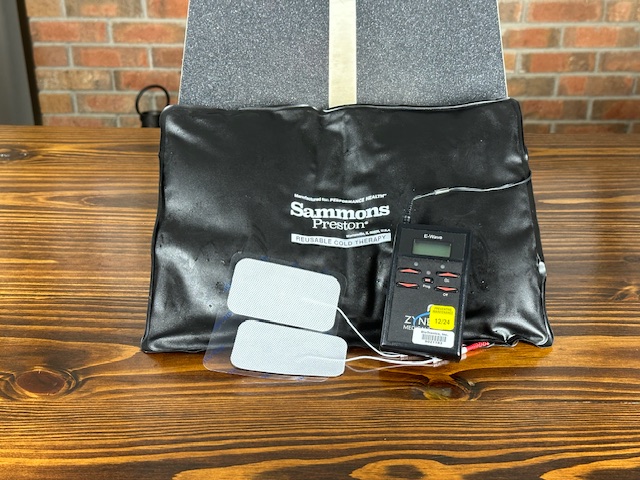
Why ice and TENS is important for treating a torn meniscus.
When you tear your meniscus, you develop what is called an effusion. An effusion is swelling that occurs within the knee joint. Sometimes there is a little bit of swelling that you can barely detect, other times there’s so much fluid you can barely find your knee cap.
In either instance, it’s important to get rid of this swelling because it plays a large role in limiting your motion and causing you pain. Icing your knee after the exercises and throughout the day will help to minimize the amount of swelling that develops in your knee. Additionally, a lot of people like the TENS, which is a form of electrical stimulation that can help to reduce the amount of pain you feel.
How to use ice and TENS for treating a torn meniscus.
I like to have my patients lie on their back with their leg propped up so the knee is above heart level, this will also help with getting rid of the swelling. Then I place the pads of the TENS unit on either side of the knee cap. I then wrap the knee in a pillow case to place a barrier between the skin and the ice, and then I’ll place one ice pack behind and one on top of the knee so the whole joint is surrounded.
Professional tips: Turn up the TENS until you feel a comfortable tingling sensation. This isn’t one of those “the stronger the better” scenarios, so only increase the TENS until it is at a very comfortable level for you. Keeping the ice and TENS on for 10-15 minutes at a time seems to be the optimal timeframe for reducing pain and inflammation.
What is the best equipment for the ice and TENS?
It’s pretty hard to beat the TENS units we have in the clinic. But considering those units are over $3,000, this portable unit with an average 4.6 star review for about $40 is an excellent alternative. This unit comes in a travel case, with two channels allowing for 4 electrode placements, and runs on a 9 volt battery. Consider this simple but effective pain relief.
These ice packs are exact replicas of the ones we use in the clinic, and our patients love them! I have had so many patients ask for a recommendation on where they can get the ice packs that we use. They are sick of hard ice packs that don’t conform, or using bags of peas from their freezer that just don’t work as well as they want them to.
These ice packs are large, reusable, and conform to various body parts so you can use them over and over again on any aching joints. I suggest you get a small and/or a medium as well as the one shaped like a triangle, and your whole body will be thanking you for years to come.
Intermediate exercises and treatments for a meniscus tear.
Now that you have mastered the beginner exercises and started to see some progress in strength, range of motion, and pain levels; it is time to move on to the intermediate phase of treatment. The purpose of this phase is to progress to weightbearing exercises in preparation for your return to normal activities.
You should continue to perform the beginner level exercises once a day and add the intermediate exercises to your program. For the best results, the following exercises should be performed 1-2 times per day, every day of the week. Intermediate level treatments should last anywhere from 3-6 weeks, or until your symptoms resolve.
1. Calf stretch on a slant board.

Why the calf stretch is important for treating a meniscus tear.
This is stretching the same muscle as the calf stretch with a strap exercise from earlier. It has the same beneficial effects as that stretch, except it is much more intense. You will feel a stronger stretch on the back of your lower leg and it will help to restore that tissue to its optimal length. Most of my patients are amazed at how this stretches out their calves, and for many of them it turns into their favorite exercise.
How to perform the calf stretch on a slant board exercise for a torn meniscus.
Start by placing the slant board in front of your counter or another stable object you can hold on to. Place both feet on the slant bord with your toes facing forward and your knees nice and straight. Stand tall and then gently lean your whole body forward and keep your heels down on the board the entire time. Once you feel the stretch in the back of your legs, hold it there for 20 seconds and repeat 5 times.
Professional tip: Start with a gentle stretch at a lower incline. Then, as you gain mobility, you can try higher inclines on the slant board.
What is the best equipment for performing the calf stretch?
Our absolute favorite piece of equipment for performing the calf stretch is the slant board, and we use this with all of our patients in the clinic. It is by far my favorite way to stretch out my own calves. You can do variations of this stretch with a foam roll, against a step, or against a wall when you are in a pinch, but none of them compare to using the slant board.
2. Heel raise and toe raise exercise.

Why the heel/toe raise exercise is important for treating a meniscus tear.
This exercise strengthens the muscles on the front and back of the lower leg. You can think of this like building a strong foundation below your knee, so it will have appropriate support below it and can function better. Additionally, when you perform the action of raising your toes off the ground, this forces your knee into a little more extension which will improve your range of motion.
How to perform the heel raise and toe raise exercise for a meniscus tear.
Start standing in front of your counter or another stable object you can hold on to. Slowly raise your heels off the ground so you are standing on tip toes, then return to the start position. Then raise your toes off the ground so you are standing on your heels, then return to the start position. Repeat both of these actions 20 times, take a 30 second break, and perform 2 sets.
Professional tips: It’s ok to gently rock forward when you go on your toes and back when you go on your heels, but try to stay standing nice and tall the whole time without too much forward and backward motion.
3. Cone step-over exercise.

Why the cone step-over exercise is important for treating a torn meniscus.
Walking with a torn meniscus can be a pretty painful activity. This is because your knee has to move through a decent portion of its range of motion when you’re advancing that leg forward for your next step. Then, when that leg makes contact with the ground, there are impact forces within the knee joint as well as on the meniscus.
The cone step-over exercise is preparing your knee and meniscus for this range of motion and impact forces, but in a controlled setting. Using the cone as a target forces you to bend your knee by moving over top of the cone. When that leg is then contacting the ground and the other leg is moving over top of the cone, we are preparing the knee for the impact forces of walking.
How to perform the cone step-over exercise for a torn meniscus.
Start by placing a cone in front of your counter or other stable surface. Grab on to the counter with your hands and stand on one side of the cone. Step directly over top of the cone to the other side and then bring your other leg over to that side as well. Then step back to the original side in the same fashion. This counts as one repetition, perform a total of 20 times.
Professional tips: Make sure to step right over top of the cone with both feet every time you step. It doesn’t count if you sneak one or both feet around the cone instead of over the top. As you get better and if this exercise is easy, you can stack cones on top of each other so it turns into a higher target.
What is the best equipment for performing the cone step-over exercise?
These stackable cones are very similar to what we use in the clinic. They’re about 7 inches tall, which is a good starting height, and then you can stack them on top of each other to increase the height of the target.
4. Forward step-ups on a stepper.

Why the forward step-up exercise is important for treating a meniscus tear.
One of the most painful everyday activities after tearing your meniscus is going up or down stairs. The steeper the height of the step, the more difficult and painful it can be, especially when you’re going down the stairs. The step-up exercise will allow you to start at a much lower height and gradually build up to a normal step over time.
How to perform the forward step-up exercise for a meniscus tear.
Start by placing a small step perpendicular to your counter or other stable surface. Hold on to the counter with one hand and step up on the platform with your unaffected leg, then bring your affected leg up on the platform. Return back to your start position by stepping backward in the same sequence.
Once you have completed 10 step-ups leading with the unaffected leg, then perform 10 repetitions leading with the affected leg. Take a 30 second break and perform 2 sets with each leg.
Professional tips: Start with a 4-inch step height when you begin this exercise. Once you can perform all the repetitions without pain and with relative ease, increase the step height by 2 inches. A normal height step is 8 inches, so I have my patients work toward this goal.
Also, use your hand on your unaffected side to hold onto the counter. Holding on with this hand will distribute your weight more evenly and take pressure off your injured knee. As you get better and gain confidence, you can try this exercise without holding on.
What is the best equipment for performing the forward step-up exercise?
For this exercise, you will want a stepper that is adjustable and that has good traction. The stepper below is nonslip and allows for variable heights so you can progress as you get stronger and feel better. These are the same steppers we use in the clinic so I know they are durable and work well.
5. Lateral step-ups on a stepper.

Why the lateral step-up exercise is important for treating a meniscus tear.
One of the last things we work on in physical therapy for a torn meniscus is lateral, or side-to-side, movements. The lateral step-up exercise allows us to practice this movement in a controlled manner, so eventually you can get back to all of the different activities you love to do. Additionally, this exercise helps to build a strong and stable knee so we can decrease the risk of this happening again.
How to perform the lateral step-up exercise for a torn meniscus.
Start by placing a small step perpendicular to your counter or other stable surface. Stand facing the counter and hold on to it with both hands and the stepper to your side. Step up on the stepper with both feet, then step down to the other side of the stepper. Then return back to your start position in the same manner going up and over the stepper with both feet.
Over and back counts as one repetition. Perform 10 repetitions, take a 30 second break, and complete 2 sets.
Professional tips: Start with a 4-inch step height when you begin this exercise. Once you can perform all the repetitions without pain and with relative ease, increase the step height by 2 inches. A normal height step is 8 inches, so I have my patients work toward this goal.
What is the best equipment for performing the forward step-up exercise?
For this exercise, you will want a stepper that is adjustable and that has good traction. The stepper below is nonslip and allows for variable heights so you can progress as you get strong and feel better. These are the same steppers we use in the clinic so I know they are durable and work well.
6. Recumbent bike.
Why the recumbent bike is important for treating a torn meniscus.
The knee joint, as well as the meniscus do not receive very good blood supply. This means that the knee receives its nutrients from the synovium that is within the capsule of the knee joint. Motion of the knee actually nourishes the joint and the best way to do this is with active motion using all of the muscles around the knee.
The recumbent bike is absolutely my favorite way to do this. You get continuous motion of your knee and you are using your quadriceps, hamstrings, and calves to propel this motion. This will help to bring appropriate amounts of blood flow to the area while simultaneously helping to get rid of swelling.
How to perform the recumbent bike exercise with a meniscus tear.
Start sitting in the bike with both feet on the pedals. Make sure the resistance is on the lowest setting and gently start to rotate the pedals forward. If you do not encounter pain or stiffness then continue to pedal until you perform a full revolution and then continue to do this at a comfortable pace for 5 minutes.
Professional tips: If you begin to pedal but feel pain in the knee or it’s just too tight, then perform this gentle rocking motion back and forth. Over the days and weeks you should gain more motion and eventually begin to perform full revolutions. Many people are able to go in reverse before they can go forward, and this is ok.
What is the best equipment for performing the recumbent bike exercise?
If you already have a stationary bike at home and it is upright, this will work just fine. But if you don’t have a bike yet then I would suggest one that is recumbent. Recumbent bikes are easier to get on and off of, especially with an injured knee. Also, the position the recumbent bike places you in allows you to have just a little more control over the motion, which is helpful in the initial phases of treatment.
As an added benefit, a stationary bike is a great way to workout. It is wonderful for burning calories if your goal is to lose weight, which has many health benefits including less impact to your knees. The bike is also great for cardiovascular health for maintaining a healthy heart and blood pressure. And finally, it’s one of the best exercises you can do for strengthening your legs and helping arthritis.
Best at Home Physical Therapy Exercises and Treatments for a Torn Meniscus Final Thoughts.
No part of having a torn meniscus is fun. But I give you credit for taking control of your situation and putting in all the work it takes to recover from a meniscus tear. Don’t forget that progress is measured in days and weeks, not hours. So be consistent, stay the course, and as long as you are making progress then you are on track for a full recovery from your torn meniscus!
Frequently Asked Questions for Treating a Meniscus Tear.
What activities should you avoid with a torn meniscus?
Any activity that involves heavy impact, twisting, or pivoting should be avoided when you have a torn meniscus. The most common activities to avoid early in treatment include running, jumping, deep squatting, and sports requiring quick agility movements. Additionally, prolonged standing, walking, and stair climbing may aggravate your symptoms.
Once you have completed a rehab program, such as the one above, a gradual return to these types of activities is possible. It’s important to slowly return to higher level activities so your knee has a chance to adapt to the stress it will be under. You should also be aware of any discomfort or swelling that occurs as a result of activity and limit this exposure.
Will a knee brace help a torn meniscus?
A knee brace is not required for a torn meniscus. Knee braces do not help with healing a meniscus tear and most patients don’t like wearing a knee brace. However, a small percentage of patients have a reduction of pain symptoms when they wear a knee brace and for those, I recommend the least restrictive brace such as the one below.
Will walking on a torn meniscus make it worse?
Walking too much on a torn meniscus can make your symptoms worse and delay healing. Depending on the severity of your symptoms, it may be helpful to use a walker or crutches to limit the amount of weight you’re placing on your leg for a few days. As swelling and pain start to resolve, you should reduce how much you’re using the crutches. Then in the later phases of healing you can begin a gradual return to walking longer distances.
What are the best exercises to heal a torn meniscus without surgery?
-Hamstring Stretch
-Calf Stretch
-Quad Set
-Straight Leg Raise
-Short Arc Quad
-Leg Extensions
-Heel slides
These exercises are a hallmark of treatment that physical therapists use for treating a meniscus tear without surgery. Detailed descriptions of these exercises including sets, repetitions, and required equipment are provided in the beginner phase of treating a torn meniscus.
Is a stationary bike good for a meniscus tear?
A stationary bike is one of the best exercises for the treatment of a torn meniscus. The primary benefit of a stationary bike is it helps to increase the range of motion of the knee. Additionally, it reduces swelling and inflammation, increases strength of the leg muscles, and helps to nourish the knee joint. Most physical therapists will use a recumbent bike in their treatment programs for a torn meniscus.
How long does it take for a torn meniscus to heal without surgery?
It takes 4-8 weeks for a meniscus tear to heal without surgery. Approximately 85% of people will be able to heal their meniscus without surgery. The most important factor in this healing is consistently performing and progressing through a high-quality rehabilitation program such as the one outlined in this article.
How do I know if my meniscus is healing?
The most important indications that your meniscus is healing is a reduction in pain and swelling, while also seeing improvements in range of motion and strength. These criteria are all important for healing from a torn meniscus and returning to normal activities. If these symptoms are not improving during the course of performing your treatment program, then it is important to notify your doctor.
What are the worst exercises to do with a torn meniscus?
Deep squatting, running, jumping, and agility are the worst exercises for a torn meniscus. Additionally, any exercise that aggravates your symptoms or causes increased swelling should be avoided in the short-term. Once you have completely healed from your meniscus tear, there is a good chance you will be able to gradually resume all of these activities.
Should I rest or exercise with a torn meniscus?
It is important to participate in an active recovery program in order to heal from a torn meniscus. This involves reducing or completely eliminating your normal exercise routine, and performing a high-quality rehabilitation exercise program. Limit the amount of weightbearing activities and exercises while you focus on range of motion in the early phase of recovery. Once your range of motion and strength has improved, you can begin a gradual return to your normal exercise routine.
Why trust Physical Therapy Simplified for treatments and exercises for a torn meniscus?
At Physical Therapy Simplified, our mission is to provide an easily accessible and highly reputable source of physical therapy information that anyone can understand, follow, and benefit from. We want you to feel confident that you are getting the best content and information that will help to reduce your pain and restore you to your highest functional potential.
The author of this article, Andrew Harkins, DPT, has demonstrated expertise in the field of physical therapy and is certified by the American Board of Physical Therapy Specialities as an Orthopedic Clinical Specialist. He has over ten years experience as a licensed physical therapist and is an expert in treating conditions related to the knee.
Andrew has worked as a teaching assistant at the University of Pittsburgh in their Doctor of Physical Therapy Program. Specifically, due to his expertise in treating knee conditions, he assisted in musculoskeletal coursework and provided instruction on how to treat meniscus tear and injuries.
